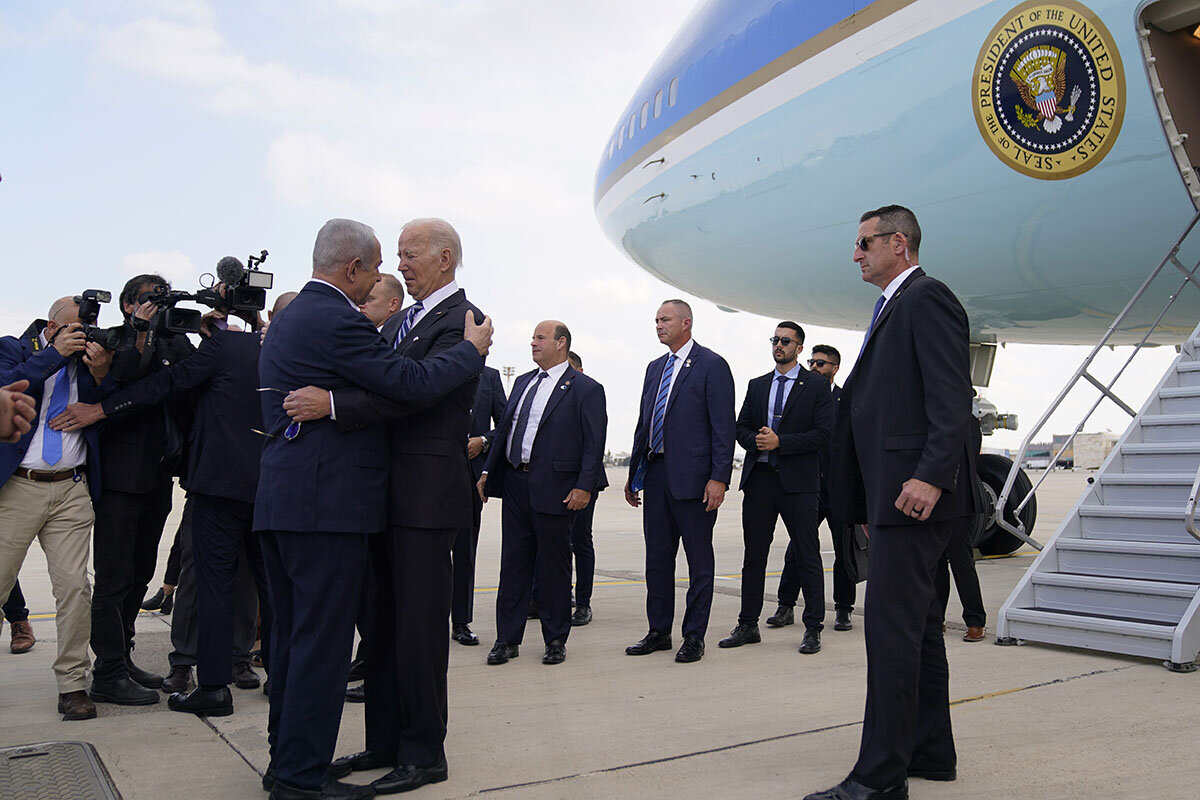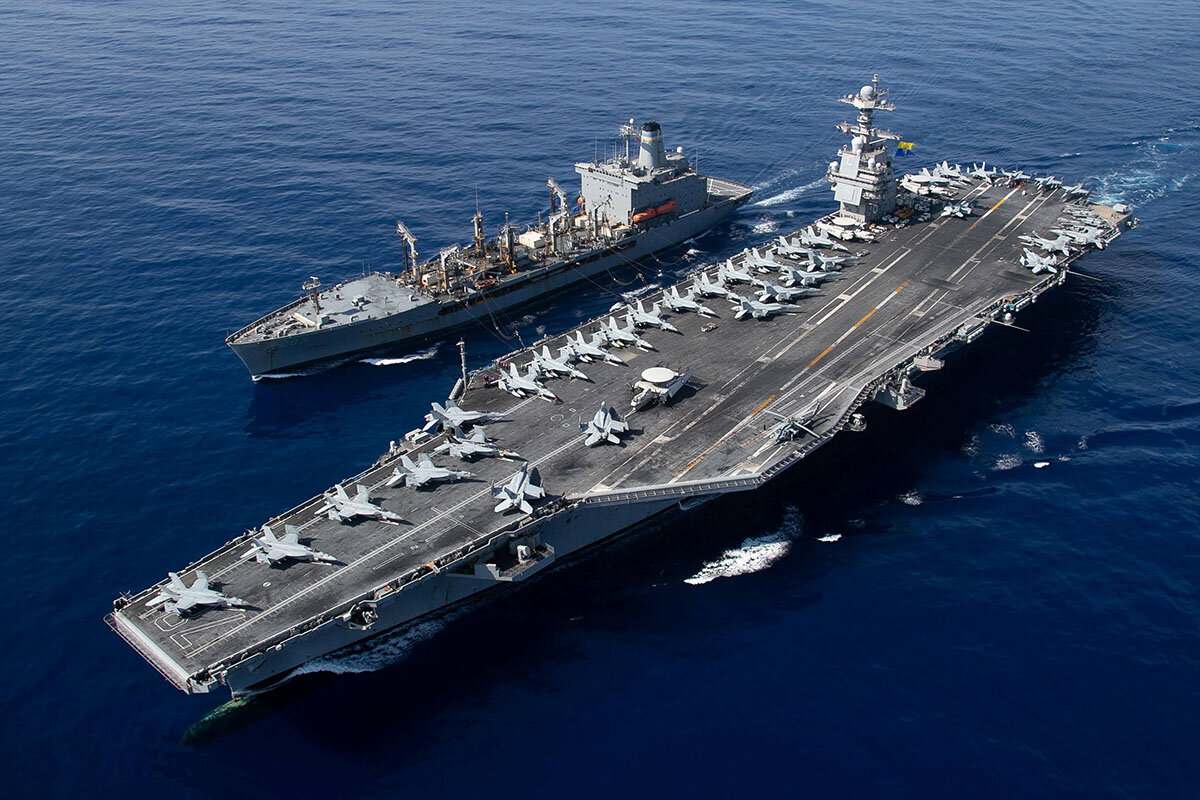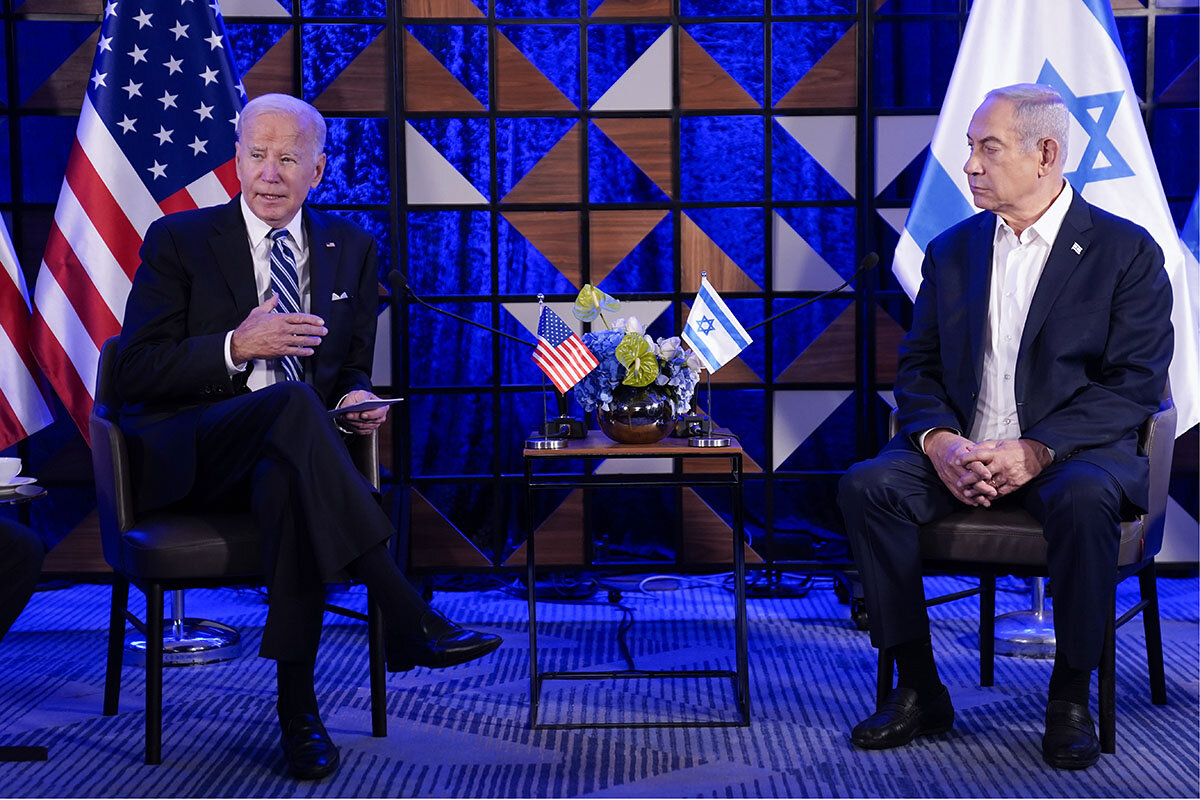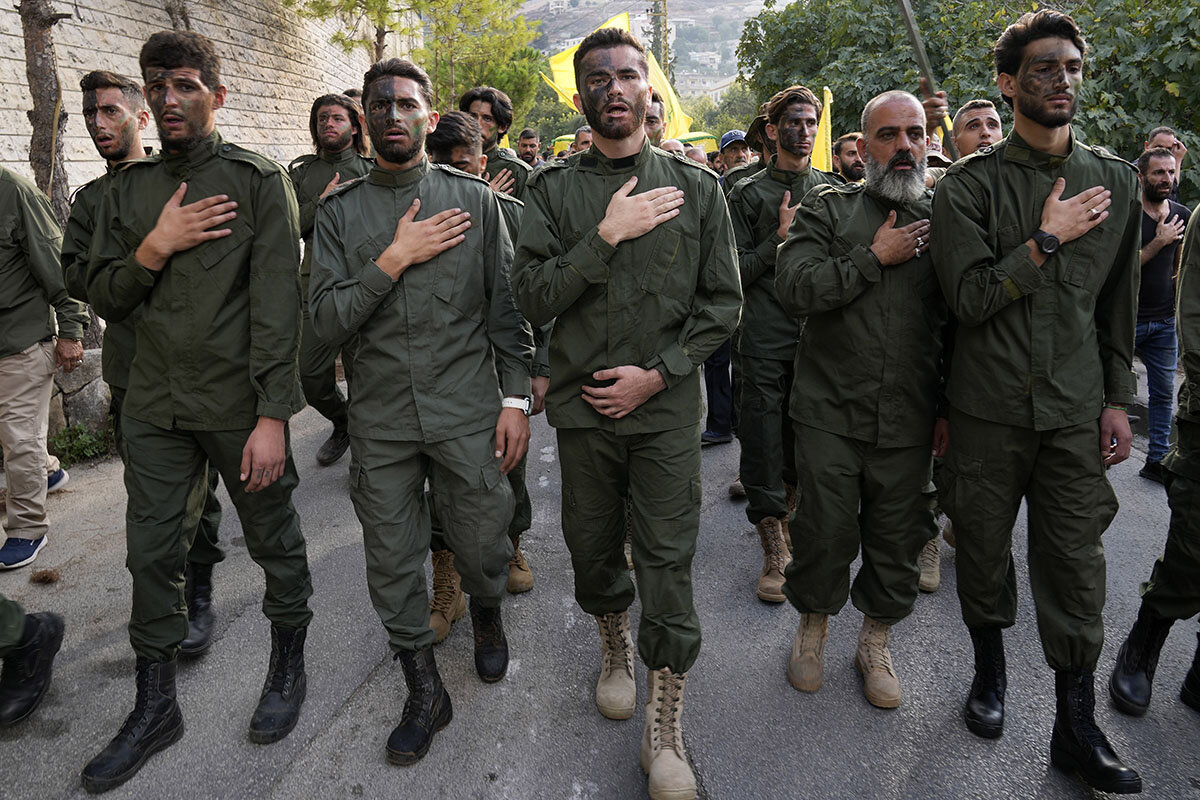Navy presence signals US bid to contain Israel-Gaza conflict
Loading...
As President Joe Biden arrived Wednesday in the active war zone of Israel, he sought to reassure one of Americaโs closest allies.ย
โI want you to know youโre not alone,โ the president said in the midst of meetings with Israelโs war cabinet. โWe will continue to have Israelโs back.โย
The pointย was borne out in the hours after Hamasโ brutal attacks against Israel Oct. 7 as Secretary of Defense Lloyd Austin announced that the Pentagon would be sending the U.S. Navyโs newest aircraft carrier, the USS Gerald Ford, and the rest of its strike group to stand at the ready off the coast of Israel should it be needed.ย
Why We Wrote This
For the Biden administration, a key goal is to project U.S. strength and resolve โ including military readiness โ as a deterrence to any widening of the Israel-Gaza conflict.
The goal,ย going beyond support for Israel,ย is to make sure hostilities donโt spread. Toย this end, defense officials have repeatedly reiterated the presidentโs warnings.
โFor any country, for any group โ or anyone โ thinking about trying to take advantage of this atrocity to widen the conflict or spill more blood, we have just one word,โ Secretary Austin said. โDonโt.โ
Deterrence, to the militaryโs way of thinking, involves no small measure of flashing its big guns.ย That goes a long way toward explaining whyย a second carrier strike group, the USS Dwight D. Eisenhower, is also on its way from its home port in Norfolk, Virginia.ย
American efforts aloneย don't ensure that the current conflict can remain contained.ย That was clear today in the face of Arab furor over a Gaza hospital explosion โ for which Israel blamed a Palestinian militia โ which complicated President Biden's high-stakes visit to the region. Yet the overturesย do help drive home the pointย that a wider war wouldย be costly for all sides, and that in anย extremityย America will come to Israel's aid.
Defense officials saidย the second carrier groupย just happened to be on its way to the neighborhood, but the power-projecting message is clear.
โTwo carrier strike groups โ I mean, thatโs a lot,โ says Mark Cancian, a retired Marine Corps colonel who studies force structure and military operations at the Center for Strategic and International Studies in Washington. โItโs a large part of our deployed naval force.โ
A Marine Corps rapid response force will join the warships, and the Pentagon has put some 2,000 U.S. additional troops on notice for a potential deployment, too.
The Air Force, not to be outdone, is sending F-15 fighter jets to โbuild on the arrivalโ of the carrier strike groups and โto respond to any crisis or contingency, and if necessary, engage and defeat adversaries,โ the service said in a statement.
As these military steps proceeded, President Biden won a pledge Wednesday that Israel will allow humanitarian assistance for Palestinian civilians to begin flowing into Gaza from Egypt, subject to inspections.ย
Role of carrier strike groups
Theย big guns are not just for show. In addition to providing humanitarian capabilities for evacuation, the carrier groupsโ air wings include advanced strike fighter jets and anti-submarine assets, along with destroyers carrying long-range Tomahawk cruise missiles and cruisersย equipped with Aegis missile-defense capabilities, notes Harlan Ullman, a former U.S. Navy commander and senior adviser at the Atlantic Council.
The carriers have attack aircraft thatย could potentially drop bombs on positions of Hezbollah in Lebanon, should the Iran-backed group enter the fighting. The planes also haveย capabilities to โscoop up signalsโ intelligence and to provide a platform โif we ever want to use special operations,โ Mr. Cancian adds. This could also come into play in the rescuing of hostages taken by Hamas, an estimated 13 of whom are American citizens.
The true success of deterrence, of course, is generally measured in not having to use these assets. Yet even as they work to de-escalate through a show of force, U.S. officials are preparing for the possibility โ however remote โ of wider conflict.
Carrier groups can be attractive targets for brazen if ill-advised attacks. There could be potshots in the form of suicidal fast boats or explosive-carrying cardboard drones that could avoid radar detection, Dr. Ullman points out.
Hezbollah possesses anti-ship capabilities, as well as an arsenal of some 150,000 โsmall, man-portable and unguided surface-to-surface artillery rocketsโ and missiles, according to the Center for Strategic and International Studies.
The Institute for the Study of War, which has published ongoing analyses of the conflict since it began, estimates that Hezbollahโs activity on Israelโs northern border โcreates opportunities for further operations against Israel.โ
Such operations and the potential risks of others have been war-gamed by the U.S. military โdozensโ of times and tend to show some obvious moves most likely to expand the conflict, says Michael Rubin, a former Pentagon official and now senior fellow at the American Enterprise Institute.
In scenarios in which Israel decides to strike at Iranโs nuclear program, for example, the war-gamed result is โHezbollah launching tens of thousands, if not 100,000, missiles down on Israel.โ
The lesson for this conflict is that if Hezbollah, in solidarity with Hamas, decides to launch an unrelenting barrage of missiles toward Israel,ย then Israel would have little incentive not to counter by striking Iran.
The fact that Hezbollah has not yet gone โall inโ with Hamasโ war on Israel actually suggests Iranian command and control, Dr. Rubin argues. โThis may sound counterintuitive, but Iran knows that if Hezbollah starts fighting, that Israel basically loses any reticence about attacking Iran.โย
Such an attack would be a colossal operation that could involve more than 1,300 Israeli sorties, by some U.S. military estimates, given that Iran is six times the size of Great Britain and four times the size of Iraq โ and given that many of the strikes, including on hard targets like nuclear reactors, anti-aircraft sites, and command and control, would need to be hit more than once.
โThen the question becomes, is Israel capable of doing it?โ Dr. Rubin says. โThe nightmare situation for the U.S. would be that Israel starts something that theyโre not capable of finishing,โ which could pull America into a regional war.
No fleet near Iranย
For this reason and others, President Biden will continue to dissuade Israel from operating beyond Gaza. Current U.S. military posture suggests it has some degree of confidence that Israel will heed this approach.ย
If the Pentagon were truly concerned about a wider regional escalation with Iran, for example, it could park its aircraft carriers in the Indian Ocean, says Dr. Rubin, who taught at the Naval Postgraduate School for more than a decade. During frequent visits to carrier strike groups, he would ask admirals what the ideal naval posture for such a scenario would be.
โTo a man, they said we should park our aircraft carriers about 400 miles off the coast of Iran.โ The logic is that it would put them out of range of surface-to-ship missiles and drones, but within range of U.S. F-18 and F-35 fighter jets.ย
For now, U.S. military posture in the eastern Mediterranean could be aimed in part at Israel, too โ specifically, to ensure itโs not tempted to launch any surprise strikes on Iran.ย
To guard against such a scenario, U.S. aircraft carrier groups could broadcast โpurposefully indiscreet chatterโ that could be picked up by, say, Iranian intelligence operatives in Lebanon as a sort of warning, Dr. Rubin says. This would quash the element of surprise needed by Israeli forces in any strike against Iran โ Israeli pilots are not suicidal, he notes โ and, in so doing, quash it.
A more likely use of U.S. intelligence assets will be in providing electronic and overhead surveillance to Israeli forces currently searching for hostages.
As for concerns that U.S. shipments to Ukraine could somehow impede the provision of arms and resources to Israel, Secretary Austinย gaveย a clear message on that front, too.ย
โThe United States can walk and chew gum at the same time,โ he said, and U.S. security assistance will continue to flow into both regions โat the speed of war.โ








